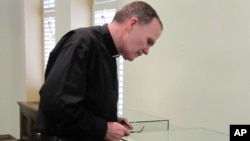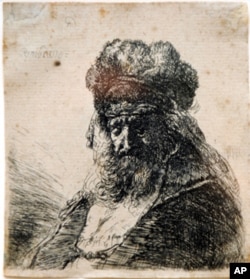A small antique etching discovered by the president of Catholic University in Washington, D.C., has created quite a cultural stir. "I don't think, in my 12 years as president, that anything has attracted so much attention so quickly as this piece of art," says the Very Reverend David M. O'Connell.
Hidden in a bathroom cabinet
The 17th century black-and-white print shows an elderly bearded man wearing a hat. It measures less than 12 by 13 centimeters, so it's not entirely surprising that it was overlooked until Father O'Connell discovered it in a bathroom cabinet in the building that serves as both his residence and office.
"I opened the cabinet, took some paper towels out and noticed the frame jutting out of the bottom under some junk, some papers and things," he recalls. "I pulled the frame out and there was this picture. I recognized the style of the picture right away, and I turned the picture over, and there was a certificate of authenticity on the back of the frame. It said 'original etching by Rembrandt.'"
That was 12 years ago. Father O'Connell says he showed the etching to some of his staff, then took it upstairs to hang in his bedroom. "I showed it to people over the years as a Rembrandt. I didn't see any particular reason to do anything with it."
Until one day in January 2009, when he invited the university archivist, Leslie Knoblauch, to see some of the artwork in his residence. When he showed her the etching, Knoblauch says, "He said, 'I think it's a Rembrandt.' I said, 'I think it is, too. We should probably get it appraised.'"
Not rare, but hardly worthless
The official verdict from an appraiser here in Washington was yes, it was created by the Dutch master.
"Its value, monetarily, is not worth that much," Father O'Connell says. "I think we had it assessed at about $4000 because there are so many like this, but only one here."
The local news media, including The Washington Post, picked up the story of the Rembrandt discovery. That prompted a secretary who had worked for Father O'Connell's predecessor to contact him and shed a little light on why the etching had been ignored. "She e-mailed me immediately and said, 'that picture was here for years in that bathroom.' Brother Gregory Nugent, for whom the building is named, said to her often 'It's worthless; it's nothing.'"
Father O'Connell says he assumes the etching ended up in the cabinet when the bathroom was painted before his arrival. Now it is the centerpiece of an exhibit in the university library, and both the reverend and archivist Leslie Knoblauch wonder what other treasures may yet be discovered on Catholic University's campus.










